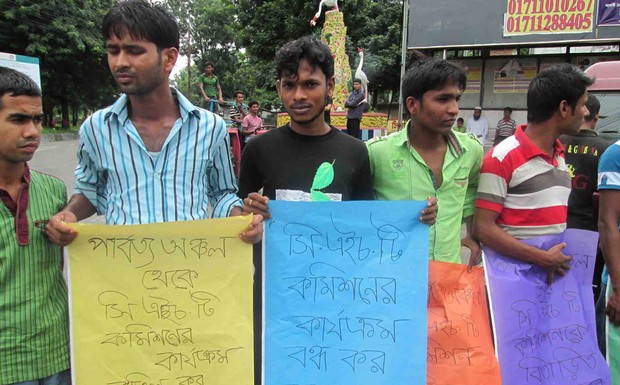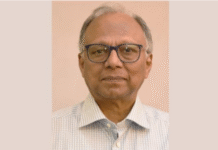One of the most intractable problems confronting Bangladesh has been the lingering ethnic conflict between the indigenous tribes of Chittagong Hill Tracts (CHT) and the Bengali settlers.
The CHT was again rocked by ethnic row between these two groups on January 10-12 this year. Reports suggested that in Rangamati district, at least ten people were injured and several properties damaged in violent clashes. The local administration immediately imposed curfew after violence began to spread to different parts of the hill district.
The CHT has been witnessing intermittent clashes between the two communities over the past few years. On February 19-20, 2010, the Bengali settlers torched about 360 houses of the local tribes. Besides, two indigenous people were killed in clashes with the security forces. Riots broke out again in July 2013 claiming at least eight lives.
Reports say the primary motive behind repeated attacks on the indigenous people is to seize their land and other properties. Thousands of people lost their land to the Bengalis after every riot. It is a matter of serious concern as most of such attacks took place in front of law enforcers. Relief workers and indigenous rights activists say local leaders of all major political parties, including Awami League (AL) patronise the Bengali settlers.
The politicians are also often accused of inciting violence in the CHT. An Inquiry Committee was set up in September 2012 but its recommendations are not attached due importance by the government. It seems a vested interest has been developed among the settlers, political parties, and security forces to perpetuate the conflict.
Such a disturbing trend has been noticed since 1978 when the Zia regime decided to settle landless Bengalis in the CHT. Consequently, the demographic composition of three hill districts—Bandarban, Khagrachari, and Rangamati has undergone a sea change. It is estimated that about half a million Bengalis have been rehabilitated so far.
The indigenous people are on the verge of becoming minorities in their own ancestral land. Facing relentless encroachment, they have organised themselves under several NGOs and local bodies. The indigenous people are now protesting against the designs of Bengali settlers and asking the government to return their land.
The ethnic minorities are one of the most deprived and persecuted lot in Bangladesh. The CHT is home to numerous ethnic groups like Chakma, Marma, Tripura, Bawm, Chak, Murong, Mro, Lushai, Khumi, Tanchangya, Khayang, and Pan Khua. All of them are of Mongoloid stock and predominantly Buddhists.
The indigenous people formed an armed group called Shanti Bahini in the early 1980’s demanding complete autonomy for the CHT. On December 2, 1997, the Sheikh Hasina Government signed the Chittagong Hill Tracts Peace Accord with the Parbatya Chattagram Janasanghati Samity (PCJSS) ending two-decade old ethnic insurgency.
Some of the salient features of the accord included recognition of the CHT as a “tribal inhabited region”, restoration of traditional governance system and role of its chiefs and establishment of regional autonomy for the indigenous people.
Expecting an amicable settlement of the vexed issues following the signing of Peace Accord, nearly 25,000 tribal people who had taken refugee in the neighbouring Indian province of Tripura, began to return home only to find to their dismay that the ancestral land had already been encroached upon by Bengali settlers. The AL Government could not succeed in implementing the accord largely due to the resistance from opposition BNP and its alliance partner Jamaat-e-Islami.
After coming to power in 2001, both the parties not only shelved the treaty but also started encouraging more Bengali people to settle in the CHT. In 2009, the AL Government reassured the tribal leaders that it would implement the accord. However, there has not been any forward movement in this regard. A Land Commission was instituted to deal with the disputes. But the body has been proven ineffective at finding a mutually accepted solution of the persistent land disputes.
The indigenous people want their land back while the Bengali settlers claim that the government provided the same to them. Large-scale immigration has led to intense competition for arable land and other forest resources in the CHT. The Parbatya Chattagram Sama Adhikar Andolan, an organisation floated by the settlers, alleges that the indigenous people are getting international assistance to fight against them.
Amnesty International, which periodically reviews the ground situation in the CHT, observes that the successive governments has failed to protect the ethnic groups’ interests and rights to security, ancestral land and participation in local governance.
The CHT has also witnessed increasing militarisation to counter the ethnic resistance movement. Indigenous activists say that they had been subjected to gross human rights abuses. The tribal people have conceded large swath of land for setting up of military camps across the CHT. The AL Government pledged to remove such camps gradually.
However, the PCJSS leaders pointed out in January 2013 that nearly 400 temporary military and paramilitary camps still remain in the region. The presence of more than 20,000 security personnel poses a threat to the indigenous people as they frequently indulge in attacks in collusion with the Bengali settlers.
The leaders of the indigenous people seek an early implementation of the Peace Accord that guarantees socio-economic development of the CHT and devolution of power at the regional level. However, the government tends to bypass the accord and imposes its will upon the ethnic minorities.
The recent riot was triggered by a street demonstration staged by the indigenous youths protesting the opening of a medical college in Rangamati. They argue that the establishment of educational institutions in the CHT neither ensure their access to higher education nor accrue any benefit in terms of employment.
The Bangladeshi ruling elites are yet to articulate a CHT policy aimed at bringing permanent peace, social harmony, and stability in the restive southeastern part of the country. It is an irony that the otherwise squabbling political leaders unite under one banner to continue to deny the indigenous peoples their just demands. The need of the hour is to initiate long-term measures in order to integrate one of the most marginalised and deprived segments of the society in the nation building efforts.
A comprehensive and inclusive policy towards the CHT would certainly facilitate Bangladesh’s emergence as a strong, democratic and vibrant South Asian nation.
Dr. Rupak Bhattacharjee is an independent political analyst based in New Delhi, India, and focuses on issues related to India-Bangladesh relations, insurgency, infrastructure development, and regional connectivity in North-East Bangladesh.
Source: bdnews24










